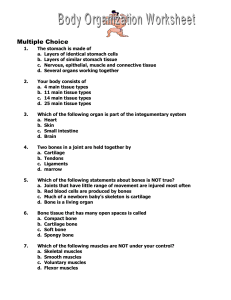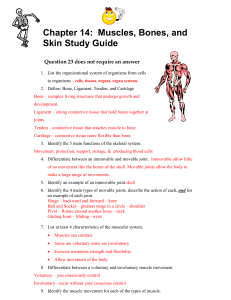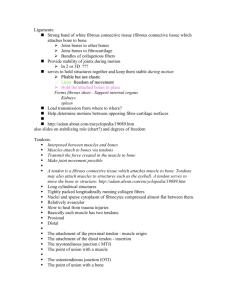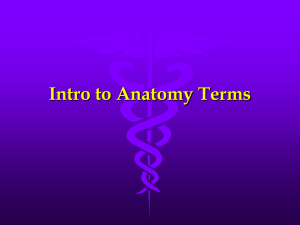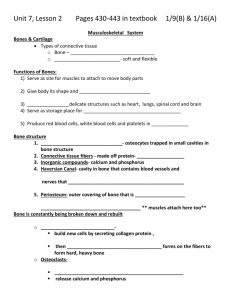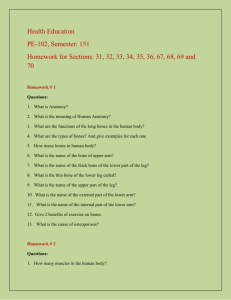MASA_PowerPoint_Basic_Anatomy_of_Musculoskeletal_System
advertisement
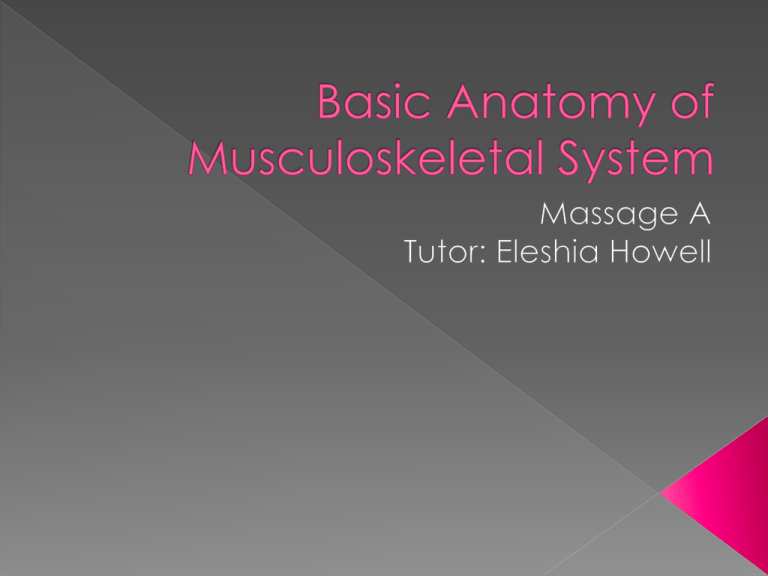
To provide a basic overview of the muscles, bones and soft tissue of the body, so you can become familiar with their names and their function(s). A&P class will cover in more depth, as will Massage B in second semester. Tip: the more you study them, the easier it will become over the next few months to piece your knowledge together! Bones Cartilage • Joints • Ligaments • • The 206 bones of the skeleton are divided into two sections – • Axial skeleton, which contains the skull, vertebral column (spine), sternum and ribs. • Appendicular Skeleton, containing the shoulder girdle, pelvic girdle, upper limbs and lower limbs. Enables movement Provides protection for organs and internal structures Produces blood cells (in bone marrow) Stores minerals, eg calcium, phosphorus, sodium, magnesium Provides attachment for muscles (important for massage therapists for palpation and assessment purposes) Also known as arthroses Various types, depending on the action of the joint Where two or more bones connect, is called an articulation. Ligaments connect bone to bone, to form a joint Allow range of motion (ROM) or movement and flexibility. Is avascular (no blood supply), tough, protective tissue capable of withstanding repeated stress Found mainly in the chest, joints and certain rigid tubes of the body (eg larynx, trachea, nose, ears) to provide a supported passageway. Most common form of cartilage is that which is found at the ends of bones to provide a smooth surface for movement. The discs between vertebrae and also between the pubic bone are forms of cartilage, as are the external structures of the ears and nose. Muscles are extremely elastic, very vascular and have the unique ability to contract and stretch to provide movement. There are 3 main types: • Smooth (involuntary) • Cardiac • Skeletal (voluntary) The Muscular system comprises of – Skeletal muscles Related fascia Tendons – attach muscle to bone • • • Motion (the body moving its parts) and Locomotion (the body moving as a whole) Motility – when the smooth muscles of internal organs produce movement. Heat production – assisting metabolism and homeostasis Maintaining posture and joint stability There are approx 640 skeletal muscles in the human body! ORIGIN: the attachment of the muscle to the least movable bone. Usually located on the medial or proximal aspect. INSERTION: the attachment of the muscle at the most movable bone site, often on the distal or lateral aspect. ACTION: what movement(s) the muscle performs, eg flexion, extension, rotation. INNERVATION: the nerve supply for that muscle Anatomical Position: For medical reference purposes the parts of the human body are described in relation to other parts of the body using a standard body position, known as the Anatomical position. The body is erect and facing forward, the arms are at the side of the body with palms facing forward and the feet are placed about hip distance apart, with toes facing forward. Physical observation / assessment are based on this standard position. Our bodies are 3Dimensional and are likewise referred to in specific sections, or planes. Sagittal (or Median) Plane: runs vertically down the body, from front to back. Cuts the body into left and right sides. Coronal (or Frontal) Plane: passes vertically through the body from side to side, creating front and back. Transverse (or Horizontal) Plane: passes horizontally through the body, creating upper and lower sections. Anterior (Ventral) – front Posterior (Dorsal) – back Medial – toward or near the midline of the body Lateral – to the side or away from midline Superior – above, or toward the head Inferior – below, or toward the feet Proximal – nearer to the point of reference Distal – further from the point of reference Homolateral (Ipsilateral) – related to the same side of the body Contralateral – related to the opposite side of the body Superficial (Peripheral) – the outside surface, or surrounding area Central (Deep) – situated at the centre of the body or structure Internal – within or inside External – outside or outer surface. Flexion – to bend or decrease the angle of a joint. Either forward or lateral. Extension – to straighten or increase the angle of a joint. Hyperextension is going beyond anatomical position. Abduction – movement away from the midline Adduction – movement towards the midline Supination – lateral (outward) rotation of the forearm (palms up...soup bowl!) Pronation – medial (inward) rotation of the forearm (palms down) Plantarflexion – extension of the ankle so that toes are pointing downward Dorsiflexion – flexing the ankle to that toes are pulled back towards shin. Inversion – turning the sole of the foot inward Eversion – turning the sole of the foot outward Rotation – circular movement when a bone moves around its own axis. Circumduction – when the distal end moves in a circle and proximal end remains relatively fixed (shoulder, hip, digits) Elevation – raising or lifting a body part, moving superiorly Depression – lowering or dropping a body part, moving inferiorly Protraction – moving forward, or anteriorly Retraction – moving backward, or posteriorly Opposition – when thumb moves toward any other digit on same hand. Lateral deviation – side-to-side movement (usually in reference to jaw) ***



